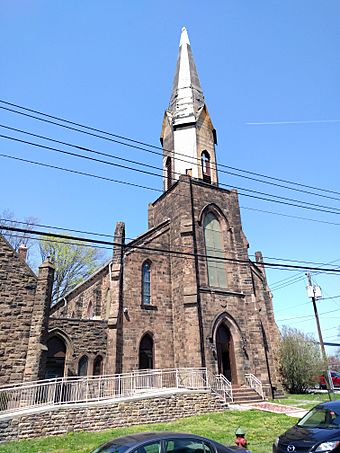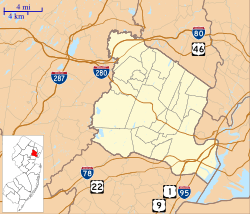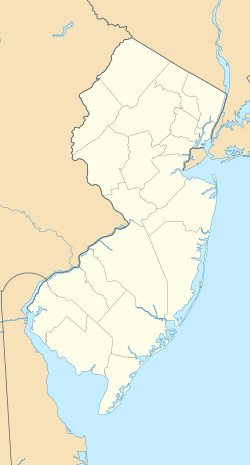Belleville Dutch Reformed Church facts for kids
|
Reformed Dutch Church of Second River
|
|

The Church in 2017
|
|
| Location | 171 Main Street Belleville, New Jersey |
|---|---|
| Area | 0.8 acres (0.32 ha) |
| Built | 1853 |
| Architect | William H. Kirk |
| Architectural style | Gothic Revival |
| NRHP reference No. | 78001756 |
Quick facts for kids Significant dates |
|
| Added to NRHP | December 21, 1978 |
The Belleville Dutch Reformed Church is a very old and important building in Belleville, New Jersey. It is also known by its official name on the National Register of Historic Places, which is the Reformed Dutch Church of Second River. This church has a long history, dating back to 1697. It was named after the Second River, a small stream that flows into the Passaic River.
Contents
A Look at Its History
Early Beginnings
The church was first founded as a Dutch Reformed church in 1697. This means it was started by people who followed a specific type of Christian faith. Over the years, the church building was rebuilt several times. It was first rebuilt in 1725, and then again in 1807.
Role in the American Revolution
The church played an interesting part during the American Revolution. Its tall steeple was used as an observation post. From here, people could watch for enemy movements. This helped protect the local community during the war.
Revolutionary War Heroes
The church also has a special connection to the American Revolution through its graveyard. More than 62 soldiers who fought in the Revolutionary War are buried right next to the church. Their graves remind us of the sacrifices made for freedom.
The Current Building
The church building you see today was constructed in 1853. It was designed by an architect named William H. Kirk. The building shows off a style called Gothic Revival. This style often includes pointed arches and tall windows, making it look grand and historic.
Why This Church Is Special
The Belleville Dutch Reformed Church is important because of its long history and its connection to American events. It is recognized as a historic place. It was added to the National Register of Historic Places on December 21, 1978. This listing helps protect the church and its history for future generations. It also means the church is considered a significant landmark in the United States.
See also




